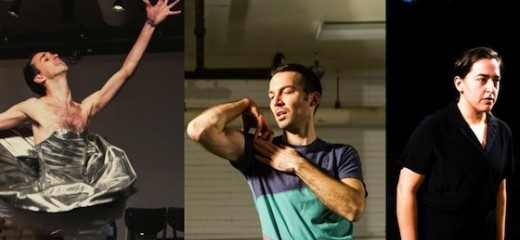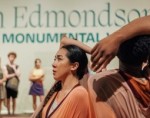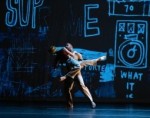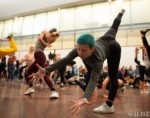
Joy in the Journey
by Patricia Graham
Thomas Choinacky perambulates the former school classroom, now a studio and performance venue. I follow his deliberate examination of a wall and find myself slowing down, noticing the details he observes and highlights with a lamp, hearing new sounds in what had previously seemed like an inert rectangle. His performance fine-tunes my senses to this place and I ease into a new awareness of the structures in front of me—some that exist and others that he builds or inhabits physically. In this movement score inspired by Choinacky’s deep interest in architecture, he illuminates and questions the structure, nature, and existence of walls. I am reminded, in an immediate way, how art can enter consciousness, quietly, through the senses.
Choinacky appears along with Mira Treatman and Sean Thomas Boyt in the first show of a new performance series, Studio Works, sponsored by Leah Stein Dance Company (LSDC), an opportunity for movement-based artists to show their work in an informal setting. The studio atmosphere is congenial and intimate. For me, the evening demonstrates something I love about seeing work in small “low tech” settings, the amazing ways one person can create something out of nothing, transforming a space and taking the audience on a journey. After the show, dialogue bubbles, the artists get feedback from friends and peers, and I’m able to chat with them about how they approach their work.
When Mira Treatman enters the performance space she speaks directly to the audience, asking for a volunteer to join her “onstage.” For a long moment we wriggle in our chairs, waiting for some outgoing person to step up. The fellow who volunteers happens to be Treatman’s uncle and he also happened to attend the ex-school we are in (Our Lady of Mount Caramel) as a child. They sit together, before us. There is a warm atmosphere between them and some awkward moments as she questions him about the details of his life, including the school, neighborhood, and his childhood friends. I wonder about Treatman’s decision-making process in shaping the questions she’s asking. The studio setting is minimal in terms of production and details come to the fore: the voices of the performers, small hesitations, their bodies in the chairs. I’m noticing the volunteer’s life as both ripe with implicit drama and also an ongoing saga of mundane incidents. After the show, Treatman explains to me some of her philosophy of performance—that when an audience witnesses “an action” by performers, it imparts deeper meaning to the actions. Her interest is in framing the quotidian details of everyday life within a theatrical setting, ideally with all of the stagecraft of full production. In this showing, when music is added to the onstage actions, it floats the performance above the mundane to the metaphorical.
Sean Thomas Boyt calls on his classical ballet training as he slips through the air, draping his lean and loopy frame around invisible corners with idiosyncratic control. If the word "quirky" weren’t so overused and unclear, I would use it to describe his patterns, rhythms, and shapes in space. He contrasts this solid chunk of technically demanding dance with a change of costume—party dress and heels—accompanied by a monologue and movement that’s jazz- and entertainer-inflected, from the world of Japanese Idol Music.
A disco ball spins colors around the darkened room. Rather than worlds colliding, it’s funky, textured juxtapositions. Boyt is interested in non-sequiturs, finding it exciting to let people make their own connections from the work. It felt autobiographic in the best sense—revealing while maintaining mystery.
In a recent conversation I had with Stein, she remarked that the opportunities she's had to continually show her own work have been fundamental to her development, and that it feels natural at this point in her career to be supporting new generations of artists. Within the context of her company's current status in a new studio, she continues a discussion with her team about what form that support will take. The Studio Works Series featured Gabrielle Revlock and John Bezark on March 26th. Kimya Imani Jackson, Leah Stein, and Sheila Zagar will present work on April 30th and Shavon Norris on May 21st. In addition to her ongoing Voice/Movement Workshops, Stein is planning an extensive training and mentorship program in August 2018.
With recent changes at the Painted Bride and elsewhere, there may be a sense of the ground shifting in the local dance community. Within the ecology of this community, there is both loss and new growth. The blossoming of LSDC’s mission in nurturing artists adds to the landscape of opportunities that have taken root from many individuals and organizations like Mascher Space Cooperative,
Leah Stein Dance Company Studio Works, The Art Room, February 26, 2018, 7-9pm http://www.leahsteindanceco.org/
By Patricia Graham
April 6, 2018










